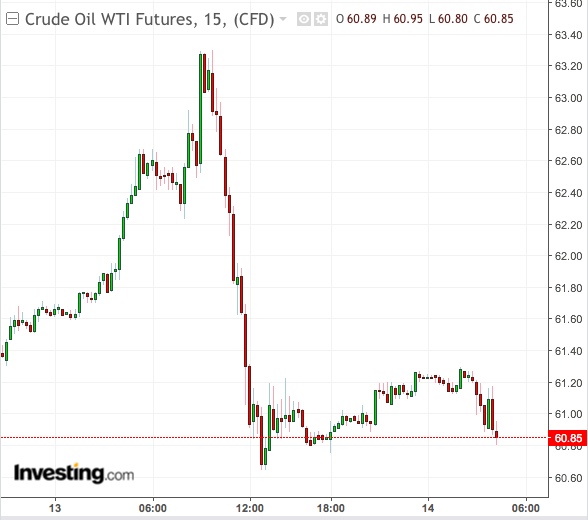Oil bulls are still scratching their heads over how it all happened. For a few hours Monday, it felt like the world belonged to them as reports of attacks on Saudi and UAE tankers in the Gulf caused crude prices to take off like a rocket in European trading. Then, in almost identical motion, the market went the other way in the New York session, as China’s counter action to new U.S. tariffs gave the day back to the bears.

While the stunning reversals and the drivers behind them are still being studied by traders to determine the merit of Monday’s activity, three things are apparent for now:
1. The Trade War Is Becoming As Important As 'Tight Oil'
The U.S.-China trade war—and its potential drag on the global economy, as well as energy demand—is emerging as big a factor to the oil market as the tightening of crude supply from OPEC production cuts and involuntary outages elsewhere.
This is especially true after China defied U.S. President Donald Trump’s warning not to resort to a tit-for-tat tariff war on Monday, imposing higher duties on a range of U.S. goods including frozen vegetables and liquefied natural gas.
Both nations now have up to 25% tariff on each other’s products, with the U.S. targeting Chinese merchandise worth more than $500 billion and China levying $60 billion worth of U.S. goods.
From speculation of a trade deal that could be done within weeks or even days, the Trump administration and the government of Chinese leader Xi Jinping seem to have grown further apart than they were a year ago, although U.S. negotiators insist that bilateral talks were still progressing and that they remained confident of a resolution.
2. There Is Not Enough Evidence To Make Iran Villain Of The Oil Market
The U.S. and its allies are going to need better proof to cast Iran as the bogeyman ready to destroy the world’s oil trade in reprisal against the sanctions that have bogged down Tehran’s own crude.
While the Iranians are guilty of adding their own negative rhetoric to that of the Americans, Saudis and Emiratis on what they might do to the Strait of Hormuz, there isn’t any evidence—publicly available as yet—that they had a hand in Sunday’s Saudi tanker attacks, despite the wide implication of the Islamic Republic’s role in the so-called “sabotages”.
Two Saudi oil tankers apparently sustained significant damage in Sunday’s incident off the United Arab Emirates coast. Separately, the U.A.E. foreign ministry reported an attack on four commercial ships also on Sunday. All these came after the U.S. deployed an aircraft carrier, bomber planes and defense missiles to the region last week, citing increased tensions with Iran.
Crude prices initially surged nearly 3% on Monday on reports about the hits taken by the tankers. But with no party claiming responsibility—and no details of case specifics that could identify potential culprits—the market quickly took a pass on the story as attention shifted to the stock market, which was sinking on news of higher Chinese tariffs on U.S. goods.
And Tehran played well its response to the crisis, urging an independent probe.
A day earlier, Reuters reported that Iran wants to be allowed to export at least 1.5 million barrels per day (bpd) of oil—triple May’s expected levels under U.S. sanctions—as a condition for it to continue honoring commitments to its 2015 nuclear deal with Western powers that President Trump has refused to recognize.
John Kilduff, founding partner at New York energy hedge fund Again Capital, said:
“It’s going to be hard to make them the villains of the oil market when their response has been so uncharacteristically dignified and calm.”
3. Prices Are Poised To Hit New Rocky Phase
Oil prices could be entering a new phase of volatility for 2019, breaking from the more enduring rallies of the first quarter.
This is because the seasonal demand spike during the summer could be followed by another swell in U.S. crude production and eventually higher stockpiles in the latter half of the year.
Monday’s price swing saw West Texas Intermediate futures move as much as $2.66 per barrel between the day’s high and low.
This the second time within a fortnight that the U.S. crude benchmark experienced near $3-per barrel volatility in a session, after the May 2 move of $2.73 per barrel.
OPEC, which will release its monthly report on Tuesday, is expected to make a strong case to continue with production cuts as dominant member Saudi Arabia shows it isn’t in any mood to give up the high prices it has worked hard to acquire since winter.
But if the global economy slows further in the second half without an unresolved U.S.-China trade war, then hedge funds may have trouble being long oil, as demand may fall short of expectations despite the likelihood of continued OPEC cuts.
Portfolio managers have already sold a total of 42 million barrels in the last two weeks, after buying 609 million over the previous 15 weeks since Jan. 8, Reuters oil market columnist John Kemp noted.
